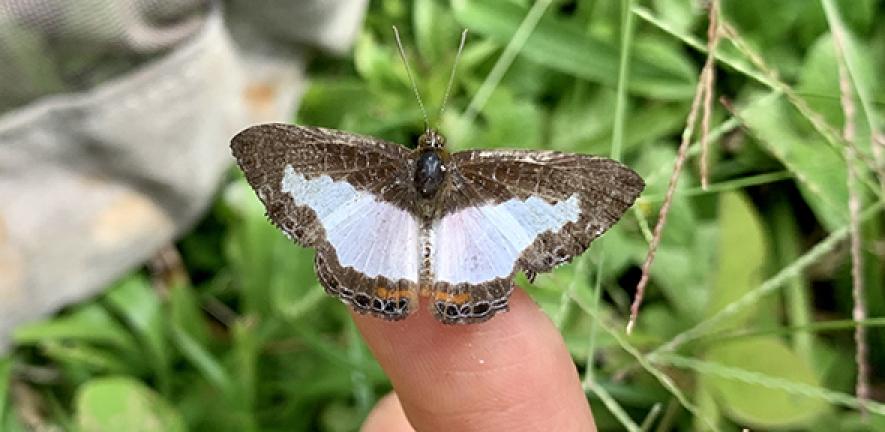UK (University of Cambridge) Small-winged and lighter coloured butterflies likely to be at greatest threat from climate change

The family, wing length and wing colour of tropical butterflies all influence their ability to withstand rising temperatures, say a team led by ecologists at the University of Cambridge. The researchers believe this could help identify species whose survival is under threat from climate change.
Ultimately all insects, including butterflies, the world over are likely to be affected by climate change.
Esme Ashe-Jepson
Butterflies with smaller or lighter coloured wings are likely to be ‘losers’ when it comes to climate change, with the Lycaenidae family, which contains over 6,000 species of butterflies, the majority of which live in the tropics, found to be particularly vulnerable.
Butterflies with larger or darker coloured wings are likely to fare better under increasing temperatures, but only to a point. Researchers say these butterflies could still experience dramatic declines if there were sudden heatwaves or if cool microclimates were lost through deforestation.
The results are published today in the Journal of Animal Ecology.
Butterflies rely on the sun’s warmth to give them the energy they need to function. They use ‘thermoregulation’ strategies to maintain a balanced body temperature against changing air temperatures.
Generally, strategies to keep cool involve adaptive behaviours like flying to a shady spot or angling wings away from the sun (thermal buffering). But when this is not possible or temperatures become too hot, species have to rely on physiological mechanisms such as the production of heat shock proteins to withstand high temperatures (thermal tolerance). Both of these strategies are needed to cope with climate change.
Researchers collaborated with the Smithsonian Tropical Research Institute (STRI) to study the thermal buffering and thermal tolerance strategies of tropical butterflies. They collected data from multiple habitats in Panama.
Equipped with hand-held nets, ecologists took the temperature of over 1,000 butterflies using a tiny thermometer-like probe. They compared each butterfly’s temperature to that of the surrounding air or the vegetation it was perched on. This gave a measurement of thermal buffering – the ability to maintain a steady body temperature against fluctuating air temperatures.
A second experiment was conducted at STRI Gamboa facilities and involved assessing butterflies’ thermal tolerance – their ability to withstand extreme temperatures, such as those they may experience during a heatwave. This was assessed by capturing a subset of butterflies and placing them in glass jars within a water bath – the temperature of which was steadily increased. Thermal tolerance was assessed as the temperature at which butterflies could no longer function.
Butterflies that had large wings tended to have greater thermal buffering ability but less thermal tolerance than smaller butterflies. Indeed, in a further study conducted by the same research team, butterflies with larger, longer and narrower wings were found to be better at thermal buffering.
Thermal buffering abilities were found to be stronger in darker-winged butterflies who could also tolerate higher temperatures than paler-winged butterflies.
Butterflies from the Lycaenidae family which have small, bright, and often iridescent, wings had the poorest thermal buffering and low thermal tolerance. If temperatures continue to rise at the current rate, forests continue to be cut down, and cool microclimates are lost, there is a very real threat that we could lose many species in this family in the future, say the researchers.
A trade-off in terms of butterflies’ cooling strategies was observed: those that were good at thermal buffering were less good at thermal tolerance and vice versa.
Scientists say this suggests that tropical butterflies have evolved to cope with temperature changes using one of these strategies at the expense of the other, and that this is likely to be due to selective pressures.
Lead author Esme Ashe-Jepson, a PhD student at Cambridge’s Department of Zoology, said: “Butterflies with physical characteristics that may help them to avoid the sun’s heat, like having large wings that enable them to fly quickly into shade, rarely experience high temperatures, and so have not evolved to cope with them. On the other hand, species which can cope with higher temperatures physiologically have experienced less selective pressure to evolve heat-avoiding behaviours.
“As temperatures continue to rise, and forest fragments get smaller and further apart because of deforestation, butterflies which rely on their surroundings to avoid high temperatures may not be able to travel between forest fragments, or cope with increasingly common heatwaves.”
The researchers say this means that species with large dark wings that are good at thermal buffering may initially be unaffected by warming temperatures, as they can continue to thermoregulate effectively using behaviour and microclimates, but their survival could be at risk if there are sudden heatwaves, or they can no longer escape to cool vegetation.
“Ultimately all insects, including butterflies, the world over are likely to be affected by climate change,” said Ashe-Jepson. “Adaptation to climate change is complex and can be impacted by other factors such as habitat destruction. We need to address these two global challenges together.”
Further research is needed to investigate the effect a warming climate may have on other life stages of butterflies, such as caterpillars and eggs, and other insect groups.
Senior author Greg Lamarre, at the Czech Academy of Science and Research Associate at STRI said: “Worldwide, most entomologists are observing drastic declines in insect biodiversity. Understanding the causes and consequences of insect decline has become an important goal in ecology, particularly in the tropics, where most of terrestrial diversity occurs.”
The research was funded by the GACR Czech Science Foundation, an ERC Starting Grant, a Smithsonian Tropical Research Institute short-term fellowship, and the Sistema Nacional de Investigación (SENACYT), Panama.
